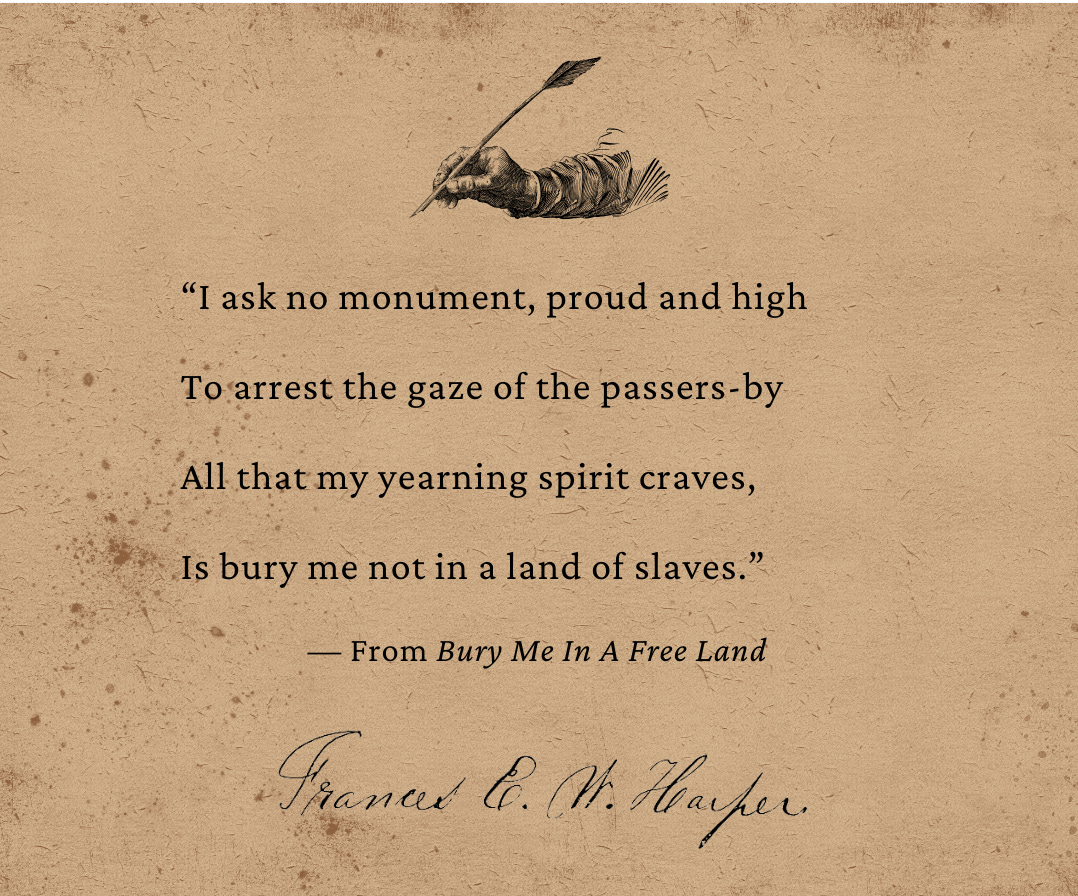Bury Me In A Free Land: the Legacy of Frances Ellen Watkins Harper
By Joanna Martin
At just twenty years old, her first volume of poetry was published. She was the first black woman in the US to publish a short story. As a conductor of the Underground Railroad, she assisted countless enslaved people to freedom. Four novels and a copious amount of poems and speeches flowed from her pen. Yet most of us have never heard her name.
It was in Jasmine Holmes’s book Carved in Ebony that I was first introduced to Frances Ellen Watkins Harper. I have always liked books like Holmes’s, which introduce short sketches of little known historical figures. They crack open a door and invite us to push in and learn more— to trace unknown people to new, soon-to-be-beloved stories.
Her Poetry
The door embossed with Frances’s name was well worth pushing wider. I discovered her poetry first. From odes to nature (Dandelions, The Sparrow’s Fall), to heartrending lines of lament over children torn from their mothers’ arms (The Slave Mother, Eliza Harris, The Slave Auction, Aunt Chloe), from Bible story retellings (Ruth and Naomi, Vashti, Crucifixion), to epics of injustice (The Martyr of Alabama, Out in the Cold, A Fairer Hope, A Double Standard), Watkins’s poetry is gripping.
Songs For the People
Let me make songs for the people,
Songs for the old and young;
Songs to stir like a battle-cry
Wherever they are sung.
Not for the clashing of sabers,
For carnage nor for strife;
But songs to thrill the hearts of men
With more abundant life.
Let me make the songs for the weary,
Amid life’s fever and fret,
Till hearts shall relax their tension,
And careworn brows forget.
Let me sing for little children,
Before their footsteps stray,
Sweet anthems of love and duty,
To float o’er life’s highway.
I would sing for the poor and aged,
When shadows dim their sight;
Of the bright and restful mansions,
Where there shall be no night.
Our world, so worn and weary,
Needs music, pure and strong,
To hush the jangle and discords
Of sorrow, pain, and wrong.
Music to soothe all its sorrow,
Till war and crime shall cease;
And the hearts of men grown tender,
Girdle the world with peace.
Her Life
Frances Ellen Watkins was born in the fall of 1825. Maryland, her birthplace, was a slave state, but her parents were free. She was orphaned at age four and raised by her aunt and uncle. Her uncle, Reverend Williams Watkins, ran a school, and it was there that Frances studied until age thirteen. Reverend Watkins was a civil rights activist and abolitionist and had a huge impact on Frances. At the tender age of 14, Frances left school and became self-supporting, working for a Quaker bookshop owner as a seamstress and nursemaid. In her small pockets of spare time, she read books from the shop and began to write down the words that bubbled within her. I picture her like that, just a young teen, already strapped with the burden of adulthood, snatching moments to indulge in the allure of words.
Her first volume of poetry, Forest Leaves, was published in 1845. At age 26, Frances moved to Ohio and became the first female teacher at the Union Seminary. This was far from the only groundbreaking step she would take. She began to travel and speak all across the US as a traveling lecturer for the American Anti-Slavery Society. Her lectures stood out in their clarity and eloquence. In 1858, she refused to ride in the colored section of a segregated trolley car, decades before the more famous protests of this type. This incident inspired the poem Bury Me In a Free Land. For a time, she lived at a station on the Underground Railroad and assisted many slaves towards freedom.
At age 35, Frances married a widower with three sons and gave birth to a daughter, Mary. Just two years later, her husband passed away, deeply in debt. Everything was taken from her, down to her bed and washtub. Yet she rallied. As a single mother, she traveled, wrote, spoke and served in various associations and committees, even delivering a speech at the famous World’s Columbian Expo in Chicago. At age 67, she wrote her most famous novel, Iola Leroy. In total, four novels, several short stories, and a large poetry collection have endured until today.
Her People
As a child in school, I read books about slavery like Amos Fortune, Free Man and Uncle Tom’s Cabin and some books that included slavery like Gone With the Wind and Elsie Dinsmore. What I didn’t read were the books by the black men and women who experienced or were eyewitnesses to slavery. I don’t know why my curriculum guided me away from first-hand accounts towards books written by authors who often softened the rough edges of slavery and discrimination or presented belittling caricatures of the enslaved, but I wish I would have been allowed to hear the stories from the lips of those who saw slavery and reconstruction most clearly. Their own voices should be platformed. As an adult, as I choose books for myself and my children, I try to prioritize original sources and learning about black history from those who actually lived it.
Francis Harper died in 1911, having seen slavery, the civil war, reconstruction, and Jim Crow. In her own words:
Further Reading Recommendations
I am indebted to Jasmine Holmes, Heritage Mom Blog, and Stories of Color for most of these recommendations.
Picture Books that I own and love:
Heart and Soul, the Story of America and African Americans by Kadir Nelson
The Secret Garden of George Washington Carver by Gene Barretta
Like A Bird: The Art of the American Slave Song by Cynthia Grady
Light in the Darkness: A Story About How Slaves Learned in Secret by Lesa Cline-Ransome
The Women Who Caught the Babies: A Story of African American Midwives by Eloise Greenfield
Before She Was Harriet by Lesa Cline-Ransome (This author has many children/young adult books about black history.)
Middle-grade/Young adult level
Instead of Amos Fortune Free Man (which is fiction and contains ugly racial stereotypes like “dog” and “wild animal” to describe people from Africa) try:
Escape from Slavery by Fredrick Douglas — the story of Fredrick Douglass’s childhood in his own words.
Nearer My Freedom by Monica Edinger — a young adult found verse version of Oluadoh Eqiuano’s autobiography. A children’s version of his book is Journey Back to Freedom by Catherine Johnson.
To Be a Slave by Julius Lester — A compilation of stories from the enslaved themselves, found in the WPA narratives
My Name is Phillis Wheatly, A story of Slavery and Freedom by Afua Cooper — the remarkable story of the famous enslaved poet
Never Caught, Young Readers Edition by Erica Dunbar — the story of Ona Judge, who escaped from George and Martha Washington.
Day of Tears by Julius Lester — a fictional account of the largest slave auction in American history.
The Underground Conductor — a graphic novel about Harriet Tubman.
Adult Level
Read Uncle Tom’s Cabin and:
Incidents in the Life of a Slave Girl — a firsthand account of a young slave mother who spends years hiding in a small crawl space in a desperate bid to protect her children. I prefer nonfiction, and this book is a must-read. It fits the February challenge of reading about a famous woman in history.
Iola Leroy and any other novels and collections of poetry by Frances Ellen Watkins Harper — her collections of poetry fit the challenge of reading a woman poet.
Yonder Come Day by Jasmine Holmes — based on the original source of the WPA slave narratives, these stories are compiled as a collective memoir of slavery.
Crowned With Glory by Jasmine Holmes — a collection of writings of black men and women who proclaimed the truth of imago Dei in the face of great opposition.
The Weeping Time by Anne C. Bailey — a highly researched story of the largest slave auction in American history. It presents a gripping picture of what was arguably the most awful aspect of slavery: forced family separations.
For first-hand accounts of slavery, read:
The Narrative of Bethany Veney: A Slave Woman by Bethany Veney
The Narrative of Sojourner Truth by Sojourner Truth
Narrative of the Life of Fredrick Douglass, An American Slave by Fredrick Douglass
For the reconstruction era, instead of Gone with the Wind (which advances belittling stereotypes of enslaved people and romanticizes slavery) read:
Jubilee by Margaret Walker — Vyry Brown’s story through the civil war and reconstruction, based on the author's oral family history.
Carved In Ebony by Jasmine Holmes — part memoir, part collection of short biographies about black women in American history. A great introduction to women you will want to learn more about.
Joanna lives on the edge of the Gobi desert in Mongolia where she attempts to grow children and houseplants and Jesus followers and English language learners. She prefers reading to almost everything else, which helps explain why her house generally looks like it experienced a rapid unscheduled disassembly.
If you weren’t already familiar with this amazing woman, we hope this article inspires you to read some of her works. Maybe you’re still looking for the right poet to complete the 10 minutes of poetry challenge! We also appreciate Joanna’s encouragement to read about history — particularly slavery and reconstruction —from firsthand accounts of those who lived it. Primary sources are always the best way to learn about a historical era!
Happy reading!
The Brighter Winter Team









I read older books more because they tend to have a healthier, cleaner feel to them. I also really enjoy attempting to extend my vocab words. Also, in my humble opinion, they were better written :)
I read many more books published before 1920 than after. That’s definitely one of my preferences. =) In my opinion, book plots back then needed more digesting (rather than just surface reading). Not that I don’t appreciate some modern reading! I just prefer the deeper plots and spiritual themes from older books. =)